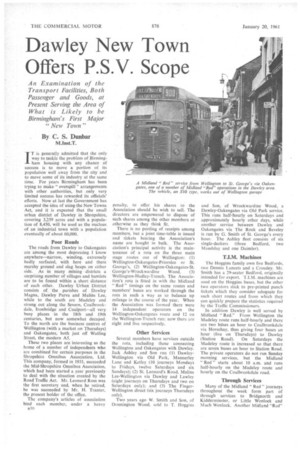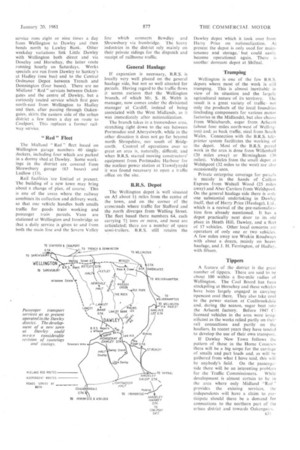Dawley New Town Offers P.S.V. Scope
Page 64

Page 65

If you've noticed an error in this article please click here to report it so we can fix it.
An Examination of the Transport Facilities, Both Passenger and Goods, at Present Serving the Area of What is Likely to be Birmingham's First Major "New Town" . By C. S. Dunbar
Minst.T.
IT is generally admitted that the only way to tackle the problem of Birmingham housing with any chance of success is to move a portion of its population well away from the city and to move some of its industry at the same time. For years Birmingham has been trying to make " overspill " arrangements with other authorities, but only very limited success has rewarded its officials' efforts. Now at last the Government has accepted the idea of using the New Towns Act, and it is expected that the small urban district of Dawley in Shropshire, covering 3,259 acres and with a population of 8,450, will be used as the nucleus of an industrial town with a population eventually of about 60,000.
Poor Roads ,
The roads from Dawley to Oakengates are among the most depressing I know anywhere—narrow, winding, extremely badly surfaced, with here arid there marshy ground and slag heaps on either side. As in many mining districts a surprising number of villages and hamlets are to be found within a short distance of each other. Dawley Urban District consists of the parishes of Dawley Magna, Dawley Parva and Malins Lee, while to the south are Madeley and strung out along the Severn, Coalbrookdale, Ironbridge and Coalport—all very busy places in the 18th and 19th centuries, but now somewhat decayed. To the north are the business centres of Wellington (with a market on Thursdays) and Oakengates, both just off Watling Street, the modern A5.
These two places are interesting as the home of a number of independents who are combined for certain purposes in the Shropshire Omnibus Association, Ltd. This company, formed in 1931, succeeded the Mid-Shropshire Omnibus Association, which had been started a year previously to deal with the situation created by the Road Traffic Act. Mr. Leonard Ross was the first secretary and, when he retired, he was succeeded by Mr. H. Tranter, the present holder of the office.
The company's articles of association bind each member, under a heavy R30 penalty, to offer his shares to the Association should he wish to sell. The directors are empowered to dispose of such shares among the other members or otherwise as they think fit.
There is no pooling of receipts among members, but a joint time-table is issued and tickets bearing the Association's name are bought in bulk. The Association's principal activity is the maintenance of a rota on the three main stage routes out of Wellington: (1) Wellington-Oakengates-Priorslee or St. George's, (2) Wellington-Oakengates-St. George's-Wrockwardine Wood, (3) Wellington-Hadley-Trench. The Association's rota is fitted in with the Midland " Red " timings on the same routes and members' buses are worked through the rota in such a way as to balance up mileage in the course of the year. When the Association was formed there were 14 independent operators on the Wellington-Oakengates route and 12 on the Wellington-Trench run: now there are eight and five respectively.
Other Services
Several members have services outside the rota, including those connecting Wellington and Oakengates with Dawley, Jack Ashley and Son run (1) DawleyWellington via Old Park, Mannerley Lane and Ketley (10 journeys Mondays to Fridays, twelve Saturdays and six Sundays); (2) St. Leonard's Road, Malins Lee-Wellington via Dawley and Lawley (eight journeys on Thursdays and two on Saturdays only); and (3) The FingerWellington direct (six journeys Thursdays only).
Two years ago W. Smith and Son, of Donnington Wood, sold to T. Hoggins and Son, of Wrockwardine Wood, a Dawley-Oakengates via Old Park service. This runs half-hourly on Saturdays and approximately hourly other days, while another service between Dawley and Oakengates via The Rock and Beveley is run by G. Smith of St. George's every hour. The Ashley fleet consists of six single-deckers (three Bedford, two Maudslay and one Daimler).
Machines
The Hoggins family own five Bedfords, two Dennis Lancets and a Crossley. Mr. Smith has a 29-seater Bedford, originally intended for export. T.I.M. machines are used on the Hoggins buses, but the other two operators stick to pre-printed punch tickets which they consider adequate for such short routes and from which they can quickly prepare the statistics required by the Traffic Commissioners.
In addition Dawley is well served by Midland "Red." From Wellington the Madeley route runs half-hourly and there are two buses an hour to Coalbrookdale via Horsehay, thus giving four buses an hour (five on Thursdays) to Dawley (Station Road). On Saturdays the Madeley route is increased so that there are seven buses an hour to Station Road. The private operators do not run Sunday morning services, but the Midland " Red " starts about 10 a.m. and runs half-hourly on the Madeley route and hourly on the Coalbrookdale road.
Through Services
Many of the Midland "Red" journeys throughout the week form part of through services to Bridgnorth and Kidderminster, or Little Wenlock and Much Wenloek. Another Midland "Red" service runs eight or nine times a day from Wellington to Dawley and then bends north to Lawley Bank. Other weekday variations link Little Dawley with Wellington both direct and via Doseley and Horsehay, the latter route running hourly on Saturdays. Works specials are run from Dawley to Sankey's at Hadley (one bus) and to the Central Ordnance Depot between Trench and Donnittgton (four buses). There are no Midland " Red " services between Oakengates and the centre of Dawley, but a curiously routed service which first goes north-east from Wellington to Hadley and then, after passing through Oakengates, skirts the eastern side of the urban district a few times a day en route to Coalport.' This replaces a former railway service.
" Red " Fleet
The Midland " Red" fleet based on Wellington garage numbers 40 singledeckers, including four which are parked in a dormy shed at Dawley. Some workings in the district are covered from Shrewsbury garage (63 buses) and Ludlow (13).
Rail facilities are limited at present. The building of a new town may bring about a change of plan, of course. This is one of the areas where the railway combines its collection and delivery work, so that one vehicle handles both smalls traffic for goods train working and passenger train parcels. Vans are stationed at Wellington and Ironbridge so that a daily service is given to and from both the main line and the Severn Valley line which connects Bewdley and Shrewsbury via Ironbridge. The heavy industries in the district rely mainly on their private sidings for the dispatch and receipt of railborne traffic.
General Haulage
If expansion is necessary, B.R.S. is locally very well placed on the general haulage side, but not so well situated for parcels. Having regard to the traffic flows it seems curious that the Wellington branch, of which Mr. S. H. Webb is manager, now comes under the divisional manager at Cardiff, instead of being associated with the West Midlands, as it was immediately after nationalization.
The branch takes in a tremendous area, stretching right down to the sea between Portmadoc and Aberystwyth, while in the other direction it does not go far beyond north Shropshire, nor south of Bridgnorth. Control of operations over so great an area is, naturally, difficult, and when B.R.S. started moving constructors' equipment from Portmadoc Harbour for the nuclear power station at Trawsfy-nydd it was found necessary to open a traffic office on the site.
B.R.S. Depot The Wellington depot is well situated on A5 about 14 miles from the centre of the town, and on the corner of the crossroads where traffic for Stafford and the .north diverges from Watling Street. The fleet based there numbers 64, each carrying 71 tons or more, and most are articulated; there are a number of spare semi-trailers. B.R.S. still retains the Dawley depot which it took over from Harry Price on nationalization. At present the depot is only used for maintenance and storage,' but could easil■ become operational again. There is ,another dormant depot at Shifnal.
Tramping
Wellington is one of the few B.R.S. depots where most of the work is still tramping. This is almost inevitable in view of its situation and the largely agricultural nature of its territory. l he result is a great variety of trafficnot only the products of the local foundries (including components for various motor factories in the Midlands), but also cheese from Whitchurch, sugar from Arlscott (about four miles north-west of Wellington) and, as back traffic, steel from South Wales. Connection with the B.R.S. teleprinter system facilitates the working of the depot. Most of the B.R.S. parcel work in the area is done from Willenhall (20 miles away) or Birmingham miles). Vehicles from the small depot at Welshpool (32 miles to the west) are also occasionally seen.
Private enterprise coverage for parcels is mainly in the hands of Collins Express from Walsall Wood (25 miles away) and Aber Carriers from Welshpool. On the general haulage side there is only one substantial undertaking in DawIe■ itself, that of Harry Price (Haulage), Ltd which is a revival of the pre-nationaliz.ition firm already mentioned. It has a depot practically next door to its old place in Heath Hill, Dawley, and a Net of 17 vehicles. Other local concerns are operators of only one or two vehicles. A few miles away are Wrekin Roadways with about a dozen, mainly on heavy haulage, and J. H. Ferrington, of Hadle, with fifteen.
Tippers A feature of the district is the great number of tippers. There are said to he about 100 within a five-mile radius of Wellington. The Coal Board has been stockpiling at Horsehay and these vehicles have been largely engaged in carrying opencast coal there. They also take coat to the power station at Coalbrookdale and, during the season, sugar beet into the Arlscott factory. Before 1947 Clicensed vehicles in the area were insignificant as the works relied partly on their rail connections and partly on the hauliers. In recent years they have tended to develop the use of their own transport.
If Dawley New Town follows the pattern of those in the Home Counties there will be a big scope for the carriage of smalls and part loads and, as will be gathered from what I have said, this will be anybody's field. On the passenger side there will be an interesting problem
for the Traffic Commissioners. While development is almost certain to be in the area where only Midland "Red provides the existing services, the independents will have a claim to participate should there be a demand For connections to the northern part of the urban district and towards Oakengales.




















































































































